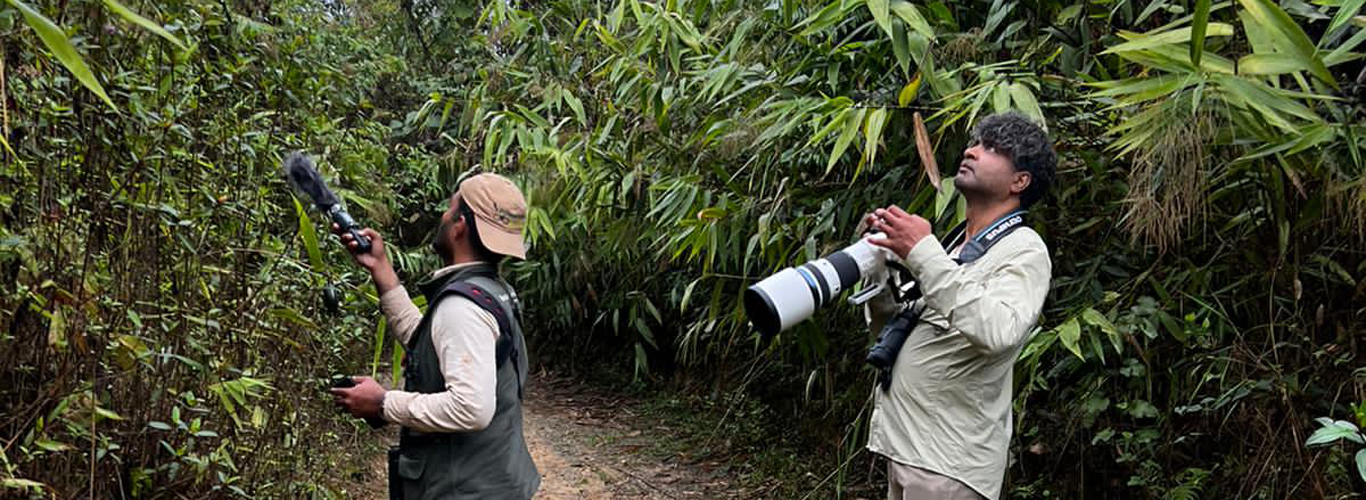Bird Call Recorders and Audio Devices
Nature call recording is comparatively a new hobby, and birds call recording or recordists are just a smaller subset of it. Like a photographer or videographer showcases the visual part by capturing the image of a subject; the bird sound recordists record the bird calls and bird songs in different seasons for studying the vocalization and behavior of birds. In India, recording bird songs has just started for the past few years, and is still in a very nascent stage.
The recordist must be very patient to get the perfect sound profile. Here on this page, we would discuss how to be a perfect bird call recordist.
Recording Bird Calls and Songs through Phone Apps for novice recordists
The bird calls can be recorded in multiple ways. For example, just use your phone as a recorder. In android or iPhone, there are multiple recording applications, and you get either the free version or the paid version. Those are really smart choices just to start with as an amateur recordist at the beginning of your birding years.
For example, “Zoom handy recorder” is an app that records single-channel sound files. After recording bird calls from the field, you can trim the file as per your requirement. However, keep the output in .wav format so that you record an almost lossless sound file.
Recording Bird Calls and Songs through low-budget sound recorders
Sony ICDs, Zoom H1N, Sekuai, Olympus WS - there are some models that are very much within the range of birds call recording. These low-budget recorders come within INR 5,000/- and are good to get hands-on experience in bird call recording. Spend some months or a year before you jump on expensive devices. Once you get the on-field experience of birds call recording and are too used to it, upgrade your recorder device.
Recording Bird Calls and Songs through professional bird sound recorders
Zoom H5, Tascam DR-100, and Zoom H6 are professional-grade bird song recorders. We use Zoom H5 during our tours for bird call recording. Zoom H5 provides the option for four different channels of recording. The recorder also supports interchangeable microphones as that interchangeable lens attachment for a DSLR camera. The shotgun mic SGH-6 is the best directional lightweight microphone one can opt for.
To bring it to the next level a Sennheiser mic can be coupled with the XLR port of Zoom H5. Further upgradation could be if one installs a parabolic dish. Parabolic dishes capture the best quality of a targeted soundwave; these are highly directional and cut off almost all the noise, even the handling noise.
Sound File types and Audio Channels
If you want to be a recordist you must understand at least these two terminologies and the least ideas of it. The best sound files depending on the file type. A professional bird song recordist would always record in .wav format in 48-bit with a 144 dB dynamic range. .wav file is like a raw image file of a camera. A 48-bit 144 dB sound file is easier to work with during the post-processing or editing of a sound file, than a 24-bit 96 dB output. So whenever you record, try to save the output format as high as you can. This generates a much better quality dynamic range sound.
Processing The Sound Files
A good recordist doesn’t process his file. However, white noise, low-frequency, and high-frequency noise, and handling noises are sometimes unavoidable to ignore. To get rid of it, audio file processors are used. The best-known application is Audacity. The birds call recordist must be extra careful that the frequency, pitch, speed, mid-tones, amplitudes, etc are unaltered; otherwise, that sound file recorded for a specific species is of no use. Sometimes just trimming to the correct length of recording is enough. Remember that, over-editing and altering parameters for bird calls generates useless files.
During our birding tours in Sikkim, we extensively record the bird songs and bird calls from Zoom H5 and SGH-6 combination. We also keep a Sony ICD UX570 handy for sudden recording or as a backup recorder. The processed files which we record during our bird-watching tours in Sikkim are further uploaded to science portals. You can join us if you want to be a recordist, and get on-field experience with veteran bird call recordists and guides. If you just join any of our tours, we would guide you to teach bird song recording and sound file processing for free.


